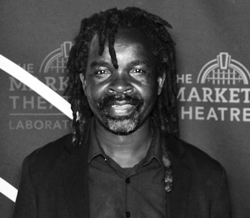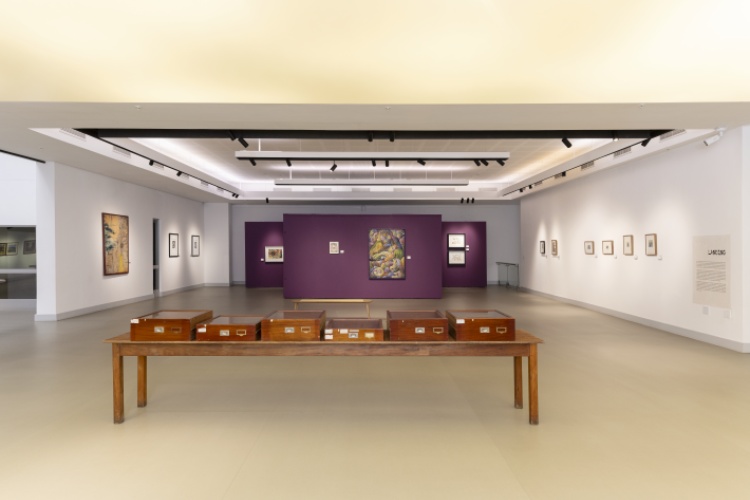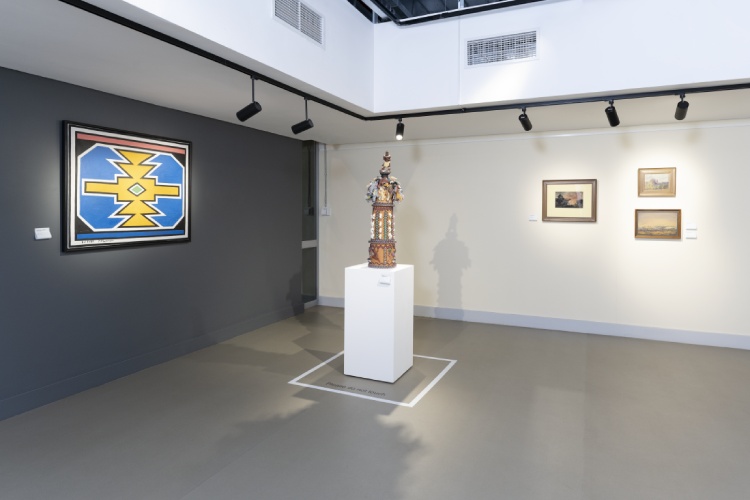We, the Purple exhibition at Javett Art Centre is living history
This exhibition at the Javett Art Centre at University of Pretoria pulls everyone to where the country comes from, where it is now and where it may be going in future.
By Edward Tsumele, CITYLIFE/ARTS Editor

There is currently an exhibition, a very important one at Javett Art Centre at the University of Pretoria which is not only useful to researchers trying to piece together a fractured history of this country, especially those interested in what the country has become after freedom, in order to map out what the future will look like.
This exhibition provocatively titled , which opened on Thursday, September 19, 2024, where invited guests were welcomed by a hearty performance by a lone vocalist supported by a solo guitarist before listening to quite intellectually stimulating speeches by among others Acting Chief Executive Officer of the centre and Khumo Sebambo, the curator of the exhibition prior to immersing themselves in the historically important art pieces inside four exhibition spaces of the centre.
Yes the opening was low key in terms of the number of guests that attended, as compared to when the Javett Art Centre opened in 2019, only to close a few months later due to the outbreak of Covid-19. Then the opening exhibition, which also marked the official opening of the centre was well attended by heavy-weights from various sectors of South Africa –the arts, academy and business to witness a new model in the arts business-a private and public partnership that saw the Javett family, a well known family particularly in art collecting circles and the university of Pretoria, come together to form this important partly private and partly public art museum.
However on Thursday, what the opening of this exhibition lacked in numbers it compensated for that with regards to the gravitas and the intellectual rigour of the exhibition. In fact Gabi Ngcobo, the person who curated the inaugural exhibition that the art world is still speaking about today in 2019, has her footprint all over the current exhibition. Therefore is in many ways, We, the Purple, reflects the one preceding it in not all but several aspects.. It is not exactly a carbon copy of the inaugural exhibition, but several of its aspects, running from the thought that went into its conceptual framework and the curatorial slant echo that exhibition. This is not to say though that this exhibition is exactly the same. The fact is, it is not, and even some of the artists whose works form part of this exhibition were not even there in the inaugural exhibition. This is however to say that the thinking thread running through this exhibition is exactly the same as the inaugural exhibition.
Maybe this should not be a surprise simply because Ngcobo, who has since left Javett to go where she has always been lauded for her curatorial expertise, that is overseas, was very much involved in the planning of this exhibition only to leave before completing the project. Here I am not going to go into the issues and the circumstances around her leaving the centre, for that is a story for another day. What is obvious though in this exhibition is that Ngcobo’s signature curatorial practice –which looks at curating particularly South African contemporary art through its often fractions race lenses, tracing that to the complicated evolution of the country itself, especially its politics, is everywhere in this important exhibition.

For example, you will not fail to notice how viewing the work of JH. Pierneef alongside that of Gerard Sekoto will draw you into the political history of this country. For example a piece by Pierneef titled Union Buildings Under Construction, which is self-explanatory and that of Sekoto that he created while based in District Six in Cape Town, a once racially mixed place that was razed down to create a whites only residential area by the apartheid rulers of the time, will remind you not only of the evil of apartheid. But it will also force you to look at both artists’ art practice, particularly their politics and place in the political evolution of the country.
These two famous south African artists were not only different from each other, the periods in which they practised art, with Pierneef belonging to another generation from that of Sekoto who came later into the art scene, sharing the period with Irma Stern among others, , but both these artists’ ideologies were directly opposites to each other. You can for example tell that Pierneef was what we could today argue without any fear of contradiction, a nationalist painter whose practice not only protected Afrikaaner nationalistic interests, but put his practice in its service. On the opposite side, it can therefore be equally argued that Sekoto’s painterly concerns were obsessed with addressing the issues of the oppressed-those at the receiving end of injustice.
Here I must also point out that it would be unfair to the curator of the show Khumo Sebambo, –the person who took over from where Ngcobo has left, to claim that she has had no input into bringing this exhibition to be a living history archive that it is. The fact is it took this curator, to bring those ideas that may have been thought through and thought about by Ngcobo into fruition in her absence. For instance it is one thing to create a framework in which an exhibition will take place, but it is quite another to physically represent those ideas by the curatorial choices that one makes, such as how best to use the space so that viewed together all these art works in four different spaces, tell a collective story of an evolving South Africa coming from that difficult past to what it is 30 years after democracy. Execution is as much critical in mounting an exhibition of this nature as the intellectual framework that forms the basis of the collective narrative in this exhibition. It is also impossible to assign the success of this exhibition solely to Ngcobo as we do not know for sure at what point of the process of this exhibition did Ngcobo exit ,and the current curator came in. Be that as it may,
However in her opening address Sebambo paid homage to Ncobo for her intial involvement in the exhibition before she exited the scene. That was quite generous on the part of Khumo Sebambo, who as guest curator has done exceedingly well in manifesting the intellectual framework that informed the basis of this exhibition as the story of South Africa’s difficult transition from apartheid to the current country that we call a free South Africa today is well captured and unmistakeably clear in this exhibition. This is living history that pulls everyone who cares about where the country comes from, where it is now, and the direction it is likely to take into the future.
Getting inspiration from its immediate surrounds of Pretoria with regards to its various curatorial curiosities, the We, The Purple exhibition forces the view to come into direct contact with the present after considering what happened in the past as represented by the various narratives contained in these art pieces. The exhibition also forced the viewer to contemplate what the future will look like.
“As South Africa marks the 30th anniversary of the country’s democracy, the Javett Art Centre at the University of Pretoria (Javett-UP) is excited to present a provocative exhibition titled We, The Purple for its 2024 curatorial programme. This immersive and reflective exhibition centres itself around Pretoria as it navigates the nation’s young democracy and invites audiences to engage with diverse perspectives and narratives.
On view at the Javett-UP for the rest of 2024, We, The Purple draws inspiration from Pretoria’s moniker, the “Jacaranda City,” an ode to its iconic Jacaranda trees lining the streets. The exhibition delves deep into the city’s historical and contemporary narratives, including pivotal moments like #FeesMustFall and the 1956 Women’s March. Notably, the exhibition’s title pays homage to the poignant “purple rain protest” of September 1989, echoing the fervour of the anti-apartheid resistance,” the curatorial stamen states.
Framed around topical conversations that mark 30 years since the first democratic elections, We, The Purple serves as a dynamic platform exploring topics from protest and identity to land rights and spirituality. The exhibition is explored through themes such as “On Pretoria/To Pretoria,” “Tshwane Ra Tswana,” “Landing,” and “Living School: Artist As…” Each facet of the exhibition promises to spark dialogue and introspection, shedding light on the intersections of art, politics, and collective memory.
The guest curator Sebambo comes with a rich history of both curating and writing about art. , She is a Johannesburg-based writer and curator , who brings invaluable experience to the curatorial process. Her recent involvement includes collaborations with INSITE, San Diego, as well as contributions to exhibitions such as The Show is Over (2022) at South London Gallery and The ‘t’ is Silent at Museum Dhondt- Dhaenens (2022), Belgium. She has contributed to journals and publications such as ASAI, ArtAfrica Magazine, The Art Momentum, in-review, Something We Africans Got, and ArtThrob. Khumo utilises her base in Johannesburg as a vantage point for reflecting on, considering, and researching new knowledge in contemporary art.
The exhibition features signature works from collections under the custodianship of the Javett-UP, including the Javett Family Collection, the Bongi Dhlomo Collection, and the South32 Collection. These include works by acclaimed artists Gerard Sekoto, Mmakagbo Helen Sebidi, John Mohl, Marlene Dumas, Athi Patra-Ruga, and George Pemba.
“The Javett-UP is also grateful for loan contributions from Tshwane based institutions including the University of Pretoria Museums and UNISA Art Gallery. We look forward to showing works by Bonnie Ntshalintshali, Zanele Muholi, and Sethembile Msezane. Thanks to the kind contribution of the Ditsong National Museum of Cultural History, visitors will have the opportunity to see a monumental sculpture by Noria Mabasa that has not been
available for public viewing for over ten years until now. Additionally, the exhibition includes loaned works by Lerato Shadi, Moshekwa Langa, Sabelo Mlangeni, Thabiso Sekgala, and Nozuko Madokwe from various galleries and collectors around the country.
The exhibition will be accompanied by a series of public programmes, including artist talks, panel discussions, and educational workshops, designed to foster dialogue and engagement around the themes it explores. This includes the Living School, a multifunctional forum that encourages active civil participation on issues raised by a curatorial project or a current political issue relevant to the socio-political climate,” the centre ssyas in a statement
On view at the Javett-UP for the rest of 2024, We, The Purple exhibition can be viewed from Tuesday to Saturday, 10 am – 5 pm, with the last admission being at 4 pm. Admission tickets can be purchased on arrival at the Javett-UP reception. Admission is free for children under 6 and all registered students from public universities.
“The Javett Art Centre at the University of Pretoria extends its gratitude to Blank Projects, Ditsong National Museum of Cultural History, Goodman Gallery, MAKER Studio, Pretoria Art Museum, STEVENSON, UNISA Art Gallery, University of Pretoria Department of Architecture Boukunde, University of Pretoria Museum, University of Pretoria Art Museum, and Vela projects.”
So you have it especially if you want some intellectual stimulation, this is an exhibition you need to see before it goes down by the end of this year. Make it part of your holiday plans if you can, just before you go far away. I enjoyed this one.










